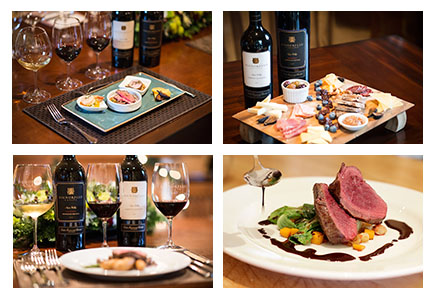A Small Grape With a Big Punch
Cabernet Franc is one of the most notable black grape varieties in the world. While it is usually grown for blending, like in Cabernet Sauvignon and Merlot, it can also be fermented by itself, as is the case with Loire’s Chinon. You may also see this diminutive blue-black grape made into ice wine in the United States and Canada.
You’ll find Cabernet Franc to be lighter than similar varieties. It’s a bright pale red in hue and tastes rather intricate, some even characterizing a glass as a “refined delicacy”. Blends featuring more robust grapes will carry a peppery perfume. Other growing regions and styles will produce aromas such as; cassis, violets, raspberry, bell peppers, and tobacco.
The first records of Cabernet Franc appearing in Bordeaux date all the way back to the 18th century, although wine historians believe it was harvested in and around Loire long before then. Much later, botanists would perform DNA analysis on these particular vines and find Cabernet Franc to be one of two “parent plants” for many sought-after blends, like Merlot.
Ultimately, Cabernet Franc is thought by many to have been established in the southwest of France in the 17th century, transported to the Loire valley by Cardinal Richelieu by way of vine cuttings. An abbot then planted these cuttings at the Abbey of Bourgueil and watched them flourish. As a result, plantings of Cabernet Franc were found throughout St Emilion, Fronsac and Pomerol by the 18th century. And they were producing wonderful wines! As popularity grew throughout the 18th and 19th centuries, more and more people began to distinguish similarities between Cabernet Franc and another popular wine of the time period, Cabernet Sauvignon. Theories began to pop up about their biological relationship. But it wasn’t until 1997 when DNA evidence would emerge, proving the familial connection–Cabernet Franc crossed with Sauvignon Blanc to create Cabernet Sauvignon.
Love Cabernet Sauvignon? Franc May Just Be The Right Fit
As a result, Cabernet Franc strongly resembles Cabernet Sauvignon. However, Cabernet Franc buds and ripens earlier than its relatives, allowing it to thrive in cooler climes. In fact, vineyards in Bordeaux will often plant Cabernet Franc as a sort of insurance policy in case of bad weather close to harvest time that could potentially damage their Cabernet Sauvignon.The plant itself is characterized by a strong and vertical trunk with dark, 5-lobed leaves. The grapes grow in long bunches; each berry small and supple, tinged blue-black, and sporting a thin skin.
Sauvignon Hoarders Rejoice!
If you find yourself hoarding bottle after bottle of Cabernet Sauvignon in your wine cellar, picking up a bottle of Cabernet Franc will provide you a magnificently tasting alternative. Cab Franc, as you’ll learn to lovingly call it, shares many aroma and phenolic compounds with your tried and true Cabernet Sauvignon. Meaning? If you enjoy a glass of one you’re bound to be similarly titillated by a taste of the other. If you enjoy the richness and intensity of Cabernet Sauvignon but want to experience a pour with more fruity and floral notes, Cab Franc can carry wafts of violets, raspberries, and blackcurrants. Moreover, with less tannins and a smoother mouthfeel than Cabernet Sauvignon, it’s sure to go down a treat.
Want The Best Cab Francs? We Can Help
Our concierges are hard at work identifying the best sources in Napa to enhance your wine collection with beautiful Cab Francs’. If you want to schedule a dedicated wine buying tour specific to this varietal we are ready to help
Feeling convinced? If you’re looking to add a bottle or two to your collection, Sinegal Estate Winery in St. Helena, CA and Signorello Winery in Napa, CA are both wonderful sources for Cabernet Franc.
Feeling inclined to explore? Here is a list with the top ten Cabernet Francs in California with our favorite being Melka.
*Image credit: Our friends at Signorello.

Leave a Reply